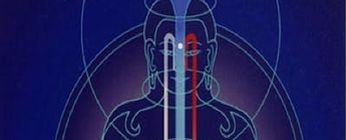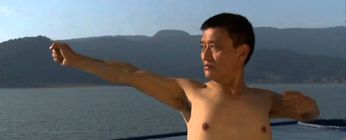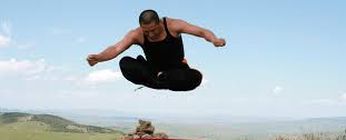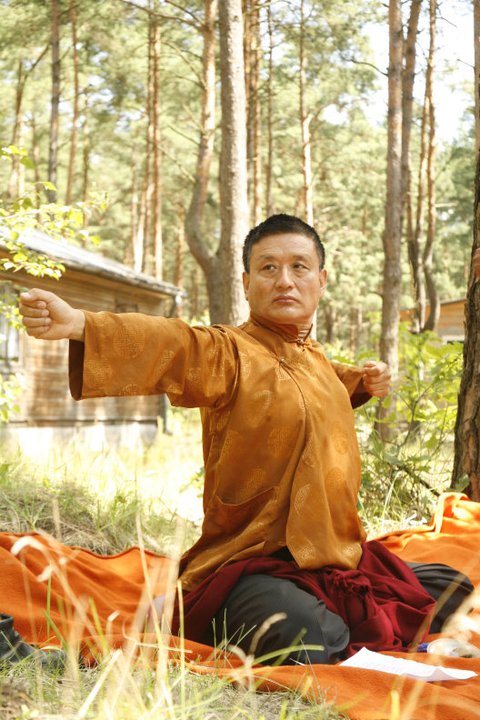
Central channel and side channels

Tenzin Wangyal Rinpoche shoots an «arrow»

You jump out of the lotus seat into the air and land again in the lotus position


Introduction
We feel the formless airflow of our breath coming and going at the tip of the nose. We allow thoughts and sounds to pass by without judging them. (30 sec)
After that, let's take a quick look at the four basic thoughts that lead us to enlightenment:
1. We recognize our precious opportunity to use this life with the means of a Buddha for the benefit of all beings. Few in the world have this luck and much less use it.
2. We remember the transience of all things: only the open, clear infinity of mind is permanent. Nobody knows how long the conditions will stay to recognize them.
3. We think about cause and effect, about how we determine what happens. Past deeds, words and thoughts became our world today. We are constantly sowing seeds for our future.
4. Finally, we understand why we work with the mind: enlightenment means timeless supreme joy. We can do little for others as long as we ourselves are confused or suffer. (30 sec)
Refuge and Bodhichitta
 Refuge Tree - Lama, Yidam, Protectors, Buddhas, Bodhisattvas (usually the teaching is still present in the form of books behind the Lama)
Refuge Tree - Lama, Yidam, Protectors, Buddhas, Bodhisattvas (usually the teaching is still present in the form of books behind the Lama)
Since we do not always experience the world as we would like it, we want to learn from those who that can already. For the best of all beings we take refuge:
➢ To the Buddhas, the enlightened state of our mind,
➢ To their Teachings that lead us there,
➢ To the liberated Sangha, and above all
➢ To the Lamas. They combine blessing, means and protection. (30 sec)
From now on, until the perfect enlightenment,
I will create Bodhichitta,
Exercise completely pure thinking, and
Give up grasping for «I» and «My».
[Recite this 3x]
The Four Immeasurable Thoughts
1. I will internalize loving kindness that desires that all sentient beings may possess happiness.
2. I will internalize compassion, wishing they may be free from suffering.
3. I will internalize sympathy, wishing that they may linger forever in joy.
4. And I will internalize the equanimity of impartiality.
[Recite this 3x]
Desired Bodhichitta
To free all wandering beings from the fear of Samsara and Nirvana, I will never give up the full enlightenment, even at the cost of my life, until I reached Buddhahood.
Authentic Bodhichitta
Gurus, Victors and your sons, please give me your attention. Just as the earlier Sugatas have created the mind of enlightenment and gradually practiced the practices of a Bodhisattva, so too I will create the mind of enlightenment and gradually walk to practice, the practices of a Bodhisattva for the benefit of all wandering beings. (3x)
Cheers
Now my life is bearing fruit. I have achieved a successful human existence and I was born today in Buddha's family and became Buddha's child.
The cultivation of conscientiousness
Whatever happens from now on, I will engage in actions that are in harmony with this family. And I will not stain this noble and immaculate family. (30 sec)
Tsa Lung Exercises
 Lama Tenzin Wangyal Rinpoche
Lama Tenzin Wangyal Rinpoche
Exercise Instructions
There are three levels of Tsa-Lung practice: the outer, the inner, and the secret levels.
The outer is the coarsest in form. It relies on body movements that strengthen the breathing process. The inner and the secret levels, however, are less body-oriented. The outer level is about the body, the inner one is Prana and energy, the secret is the mind or awareness.
Before you start practicing, do the nine breaths of cleansing as described in the Shamanic Practices section.
Instructions for the ninefold purification breathing
Taking the five-point meditation posture
Sit cross-legged, spine straight, chest open, hands resting in equanimity (palms up, left hand resting on right) about four fingers below the navel, neck slightly bent forward. (30 sec)
Visualize the Three Channels
The blue central channel goes straight through the center of the body. It is visualized in the size of the stem of a bamboo arrow, and it becomes a bit broader from the heart to the opening at the top of the head. The side or beside channels, one white and one red, are slightly narrower in diameter than the central channel and connect to the central channel at its base. The connection of the channels is four fingers below the navel. The side channels in the body on both sides of the central channel straight up, curve under the skull roof, go behind the eyes down and open each in a nostril. The right channel is white and represents method; the left channel is red and represents wisdom.
In the further course of the instructions, it may be that the channels are described in reverse. That's right, as mentioned here:
Buddha himself is always pictured on the right side. This relieves the positive white channel (left) and slightly compresses the negative red channel (right).
The first three breaths
Lift the right hand and press the base of the ring finger with your thumb. Close the right nostril with the ring finger. Inhale the pure air element in the form of green light through the left nostril and fill with it the red channel.
Move your hand over to the other side of your nose and close the left nostril with your right ring finger as you exhale through the right nostril. Imagine the air moving up the white channel and being released in the form of blue air.
With each exhalation, ne-diseases associated with wind, dön-obstacles caused by disabling male beings and dripa, mental obscurations associated with aversion and anger, along with the influences from the past, are ejected through the white channel.
The second three breaths
Change the hand and nostril and inhale the pure air element through the right nostril. Green light fills the white channel. Then close the white channel, exhale and expel the impure air through the left red channel upwards and in the form of red air.
With each exhalation through the red channel, diseases associated with bile, obstacles caused by disabling females, and mental obscurations associated with attachment, desires, and greed, along with influences from the future, are expelled.
The third three breaths
With the hands in the Mudra of equanimity, you inhale the pure air element in the form of green light through both nostrils. The rough exhalation of impure air passes through both nostrils. The subtle wind moves up through the central channel and beyond the highest point on the head in the form of black smoke.
With exhalation, diseases associated with phlegm, obstacles induced by Nagas and mental obscurations associated with ignorance, lack of trust and doubt, along with contemporary influences, are expelled.
If you already know how to do it, does guru yoga, take refuge, and create in yourself the motivation to practice for the well-being of all beings. In the end, dedicate the merit of your practice to all sentient beings. In this way your practice becomes another step on the path to enlightenment.
It is best to do the following exercises in the morning. You can do it once, three or five times. Practice with your eyes open or closed. Try out what suits you better. The goal is to do the exercises in such a way that the mind dwells in non-dual awareness.
Dedication
(ngo mön)
GO SUM DAK PE GE WA GANG GYI PA
KHAM SUM SEM CHEN NAM KYI DÖN DU NGO
DUK SUM SAK PE LE DRIP KÜN JANG NE
KU SUM DZOK PE SANG GYE NYUR TOP SHOK
All pure virtue done through the Three Doors,
I dedicate to the welfare of all sentient beings of the Three Realms.
Having purified all afflictions and obscurations of the Three Poisons,
May we swiftly achieve the complete Buddhahood of the Three Bodies.
Dedication prayer
(ngo wa)
KYAP NE SUM LA DING CHEN TOP PAR SHOK
GO SUM NYAM TOK YE SHE GYE PAR SHOK
DUK SUM DAK NE KU SUM TOP PAR SHOK
RANG GYÜ DRÖL NE ZHEN LA PEN PAR SHOK
May I gain great confidence in the Three Refuges.
May my experiences and my realization of wisdom of the Three Doors increase.
By purifying the Three Poisons, may I receive the Three Bodies.
By liberating myself in my own being, may I benefit others.
Explanation of the terms in the dedication:
Three Doors — Body, Speech, Mind
Three Realms — desirable, shape, shapeless
Three Poisons — Aversion, Desire, Ignorance
Three Bodies (or dimensions) —
bön ku or Dharmakaya;
dzok ku, long ku, or Sambhogakaya; and
trül ku or Nirmanakaya
